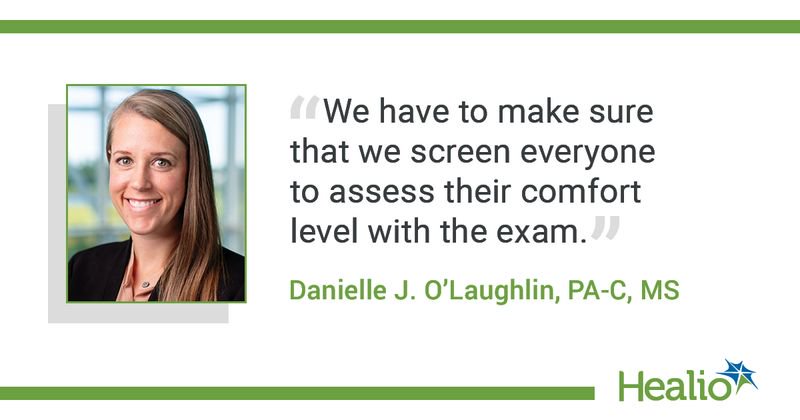Q&A: Steps clinicians can take to ease anxiety, fear about pelvic exams
Addressing patients’ anxiety about pelvic exams could help prevent them from delaying or avoiding the procedure, according to a paper recently published in Primary Care and Community Health.
Previous research suggests that fear and anxiety are common among patients in the OB/GYN setting. A 2018 national survey showed that nearly 40% of women were at least “somewhat concerned” about what would happen during their first OB/GYN exam. In addition, a 2020 analysis found that 13.2% of women have postponed going to a clinic for contraception to circumvent having a pelvic exam. The same analysis also showed that 38.2% of women would rather not have a pelvic exam.

Despite concerns, Danielle J. O'Laughlin, PA-C, MS, one of the authors of the Primary Care and Community Health paper, said it is important for women to undergo the procedure.
“We have to be able to treat patients and get the appropriate information,” she told Healio Primary Care. “We want to make it as comfortable for the patient as we can.”
O’Laughlin, who is also a member of the department of community internal medicine at Mayo Clinic, provided more information about how physicians and advanced practice providers can address women’s concerns and the importance of doing so.
Healio Primary Care: What evidence is there to suggest that fear and anxiety cause women to delay or avoid pelvic exams?
O’Laughlin: The literature shows women who have gone through any type of sexual abuse, sexual trauma or rape are more likely to have PTSD related to specifictriggers of the event that they experienced. For instance, speculum insertion may remind them of the uncomfortable penetration that occurred had with the abuse or trauma.
Healio Primary Care : Why do some patients experience fear and anxiety during pelvic exams?
O’Laughlin: The answer depends on the individual patient. Some people are predisposed to anxiety. As I mentioned earlier, we see that people who have had sexual trauma or sexual abuse can be predisposed to having more anxiety. In addition, women with certain medical conditions or women with chronic pelvic paincan have more fear and anxiety with the procedure related to the uncomfortable nature of the exam itself. We also see anxiety in younger women because they have not had previous experience with pelvic examinations. . But we also see older women with fear and anxiety, perhaps due to concerns on what the exam may find..
Healio Primary Care: How should physicians tailor interventions based on patients’ age?
O’Laughlin: The first step is to always have an awareness to a woman’s fear and anxiety. Sometimes patients will bring it up before we start but not all patients will. So, we have to make sure that we screen everyone to assess their comfort level with the exam.
Education is really important, especially in younger women or women who have not had a previous pelvic examination. We should be talking about pelvic exams years before they have to have their first one because it can help prepare them for the examination. Showing patients the equipment that you will use during the exam and using visual aids or diagrams can be helpful. The option to have a support person, such as a nurse, family member or friend present during the exam can be reassuring for patients when they are in a difficult situation. Physicians and advanced care practitioners can also ensure proper positioning and draping, use terms that are less threatening, perhaps use music therapy or aroma therapy. With older patients, controlling their underlying health conditions can also improve the pelvic exam experience.
Healio Primary Care: Why is it important for physicians to take the initiative to address fear and anxiety about pelvic exams?
O’Laughlin: There is always a hesitancy among patients to bring their concerns up to providers. Therefore, it is our job as providers to screen everyone, even if we think that the patient has tolerated a pelvic exam before and never had problems.
We can accomplish this by asking patients about their comfort level surrounding a pelvic exam, if they have any fear or anxiety and if they have any questions about the procedure. We should also make sure that we are checking the patient’s chart to see if there’s a history of a related medical condition, chronic pelvic pain, anxiety and/or past trauma, so that we know our patients better. This can help facilitate and tailor the exam to make it a more positive experience for patients. Though most women do not enjoy pelvic exams, we have to ensure we help prevent certain medical conditions and help control some chronic diseases.
References:
Holt HK, et al. J Gen Intern Med. 2020;doi: 10.1007/s11606-020-06334-8.
O’Laughlin DJ, et al. J Prim Care Community Health. 2021;doi: 10.1177/2150132721992195.
Orlando Health Press Release. https://www.eurekalert.org/pub_releases/2018-05/m-mwo050818.php. Meeting with OBGYN prior to first exam empowers young women in medical settings. Accessed Feb. 24, 2021.

